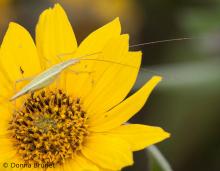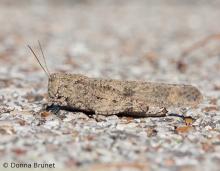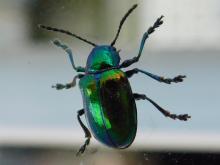Land Invertebrates
Media

Species Types
Scientific Name
Tetragnatha spp.
Description
Longjawed orbweavers are called stretch spiders because they rest with their legs stretched straight out in front of and behind their slender bodies. They build their circular webs horizontally, within a few feet above the surface of a stream or lake.
Media

Species Types
Scientific Name
About 84 species in North America.
Description
Many blow flies are so shiny and colorful they’re called greenbottles and bluebottles. But pretty as they are, it’s hard not to be repulsed by their larval diets.
Media

Species Types
Scientific Name
About 20 species in North America in subfamily Oecanthinae
Description
Tree crickets, or pale bush crickets, are a subfamily of crickets that are little seen but often heard. True to their name, instead of living on the ground, they live in trees, bushes, and tall herbaceous plants.
Media

Species Types
Scientific Name
Dissosteira carolina
Description
The Carolina grasshopper is frequently seen in dusty, open habitats like dirt roads and vacant lots. Its yellow-bordered, black hindwings make it look like a mourning cloak butterfly.
Media

Species Types
Scientific Name
Chrysochus auratus
Description
The shiny, iridescent dogbane beetle is one of Missouri's most beautiful insects. As the name indicates, this beautiful beetle feeds on dogbanes.
Media

Species Types
Scientific Name
Phanaeus vindex
Description
Although most dung beetles are dull black, the rainbow scarab is bright metallic green and copper.
Media

Species Types
Scientific Name
Zelus luridus
Description
The pale green assassin bug, Zelus luridus, is one of nearly 200 species of assassin bugs in North America. Like other assassin bugs, it is a predator that captures and eats other insects.
Media

Species Types
Scientific Name
Misumessus oblongus (formerly Misumenops oblonga)
Description
The green crab spider has spines, and the entire body and legs are pale green to silvery white. Like other crab spiders, its legs extend outward from the sides, and it can walk in any direction.
Media

Species Types
Scientific Name
Schistocerca spp.
Description
About six species of bird grasshoppers occur in Missouri. Most are attractively marked, large insects that gracefully fly from danger, almost like birds.
Media

Species Types
Scientific Name
Cicindela limbalis
Description
The common claybank tiger beetle, or green-margined tiger beetle, occurs on dirt clay soils in open areas in spring and, less abundantly, in late summer. Color varies from red to purple to green. The outer shell edges are often edged with shiny green.
See Also



Media

Species Types
Scientific Name
Cisseps fulvicollis
Description
The yellow-collared scape moth is more often “orange-collared.” And whether you think it looks more like a firefly or a wasp, it’s still a moth!
Media

Species Types
Scientific Name
Nearly 150 species in North America north of Mexico
Description
Slim, delicate plume moths are instantly recognizable by their T-shaped silhouette, long legs, and muted shades of tan and brown. It can be hard to separate the various species.
Media

Species Types
Scientific Name
Pyrrharctia isabella
Description
Not many people know the adult Isabella tiger moth when they see one, but we’re all acquainted with its caterpillar, the woolly worm, or woolly bear.
About Land Invertebrates in Missouri
Invertebrates are animals without backbones, including earthworms, slugs, snails, and arthropods. Arthropods—invertebrates with “jointed legs” — are a group of invertebrates that includes crayfish, shrimp, millipedes, centipedes, mites, spiders, and insects. There may be as many as 10 million species of insects alive on earth today, and they probably constitute more than 90 percent all animal species.





















